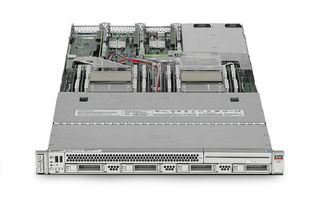Oracle reveals raft of Xeon E5-based Sun servers
The Silicon Valley giant launches five servers based on Intel’s latest Xeon E5 chips.

Oracle has become the latest hardware player to launch new servers based on Intel's Xeon E5 processors.
Oracle's collaboration with Intel provides solutions with great performance and scalability to meet the ever increasing demands of datacentre customers.
The new line uses Sun technology to provide what the company claims to be the "best x86 platform," despite coming to the market later than its more traditional server vendor rivals, HP and Dell.
The range has still received full support from the processor
manufacturer.
"Oracle's collaboration with Intel provides solutions with great performance and scalability to meet the ever increasing demands of datacentre customers," said Doug Fisher, corporate vice president of the software and services group at Intel.
"Extensive co-engineering, testing and validation have gone into creating an excellent balance between processor, memory and I/O resources in the solution stack. As a result, Oracle's x86 servers based on the Intel Xeon processor E5-2600 offer an unprecedented ability to move large volumes of data efficiently and handle multiple millions of transactions per second."
Get the ITPro. daily newsletter
Receive our latest news, industry updates, featured resources and more. Sign up today to receive our FREE report on AI cyber crime & security - newly updated for 2024.
There are five new machines in all, three racks and two blades, all of which are two sockets.
First up in the Sun Fire X4170 M3. With 16 DDR3 memory slots, the box can handle up to 512GB of memory. Both 2.5 and 3.5in drives can be accommodated with the choice of SAS, SATA and SSD all supported. It also has four Ethernet ports, but speeds for these slots have increased to 10Gigabits for the first time. The server also provides six USB ports and four PCI Express 3.0 slots.
Next in the range is the Sun Fire X4270 M3 which provides more space for cards and drives as it slots into a 2U high-rack chassis. Both 2.5 and 3.5in drives are again supported, but users can deploy double of the former into the box. Memory also goes up to 512GB and the second server also comes with four 10GbE slots, but ups its PCIE ports to six.
The third launch is the Sun Blade X6270 M3, which ups its memory slots to 24. However, it utilises RDIMM sticks instead, decreasing memory capacity to 384GB. Four 2.5in drives can be deployed in the server, but again the choice is narrowed to wither SAS or SSDs. Networking capabilities come through an external ExpressModule, which includes the option of 10GbE connections.
The final two servers fall into the Netra range, which was created by Sun in the mid-nineties to serve telecoms companies or firms wanting to run telecoms applications internally.
First of these two launches is the Netra X4270 M3. With similar specs as its Sun Fire counterpart, the server only takes a maximum of eight drives with only 2.5in options on the table. With 16 memory slots, things are looking up but these are again only capable of taking 8GB or 16GB products, leaving memory at 256GB.
The final announcement was the Netra X6270 M3. This blade server keeps to the exact same specs of its Sun Fire counterpart but, as with all Netra servers, is made more "rugged" to withstand issues thrown at it, ensuring constant telecoms availability.
"Oracle engineers hardware and software together to deliver maximum performance, reliability and cost savings," said Ali Alasti, vice president of hardware engineering at Oracle.
"Whether you're looking to support new applications or deploy in the cloud, Oracle's new x86 servers are ideal platforms for Oracle software with comprehensive management, virtualisation and support built-in."
Jennifer Scott is a former freelance journalist and currently political reporter for Sky News. She has a varied writing history, having started her career at Dennis Publishing, working in various roles across its business technology titles, including ITPro. Jennifer has specialised in a number of areas over the years and has produced a wealth of content for ITPro, focusing largely on data storage, networking, cloud computing, and telecommunications.
Most recently Jennifer has turned her skills to the political sphere and broadcast journalism, where she has worked for the BBC as a political reporter, before moving to Sky News.





